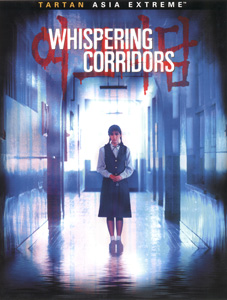Film
Index
Cries and Whispers: If ever there were a title that reflects the narrative strategies of the new wave of Asian horror movies, Whispering Corridors is it. It suggests both an insinuation of secrets and dark pathways. It hints rather than states. It is quiet and understated. It's a title that Val Lewton might have liked. Whispering Corridors is one of the first films in the movement, too (Tartan's new DVD trumpets it as "the one that started it all," though Hideo Nakata had already made his debut at the time), so an argument can be made that it helped set the stage for films like A Tale of Two Sisters and Dark Waters. The film itself is somewhat more forthright than its title, though.
Synopsis: The plot kicks off with a teacher in a Korean girl's school who suspects that one of her pupils is more than what she seems. The teacher lets her fears be known to the newest teacher, an alumnus of the school herself, before she is found dead. Apparently, she hung herself, but the new teacher begins to piece together darker motivations. Drawn into the web of the story is the girl who finds the body of the dead teacher, who begins to become the center of ghostly happenings herself. When she begins to act erratically, she draws the ire of the institutional corporal punishments dished out by her homeroom teacher. Meanwhile, she has a new friend, who encourages her to explore her interest in art. But her new friend has secrets of her own....
Girls in the Boy's Club: The most interesting thing about Whispering Corridors isn't that it employs prototypical elements that will come to typify the contemporary Asian ghost story--it doesn't really utilize those elements at all, for the most part--but that it represents a sea change in the target audience sought by the horror movie. It is fair to say that horror movies have traditionally appealed first and foremost to an adolescent male audience. This is a gross simplification, of course, but since the advent of the modern horror movie in the late sixties, I suspect that this is true. Whispering Corridors, much like some of the other Asian horror films that follow closely on its heels, is interested in a female audience. To this end, it utilizes its setting in a different manner than a male-targetted horror movie would. It gets inside the interior lives of teen-aged girls. The relationships formed in the film are primarily the kinds of relationships women enter into. Our pair of teen heroines form a friendship that would be anathema to teen-aged boys. This is very canny on the part of the filmmakers, because an unspoken truth about movie marketing is that the biggest hits in the history of movies all cater to a female audience. It certainly wasn't teen-aged boys who made Titanic the biggest hit in the history of movies...
We Don't Need No Education...:Of course, holding up a mirror to the concerns of a female audience is only half the story. The other half stems from the film's other central concern. While Whispering Corridors is superficially related to The Ring and its progeny, the film with which it shares the most is Kinji Fukasaku's notorious Battle Royale. Like that film, Whispering Corridors finds in education a social institution that is chewing up and destroying its charges. The scenes of institutional brutality in the film are alien to Western audiences, I'm sure, but are symptomatic of a system that has clearly jumped the tracks. Director Park, like Fukusaku, has looked at an institution that has a high rate of suicide and drawn his own conclusions. Without the destruction wrought by the system, there is no ghost or ghost story in the first place.
The ghost story itself works in fits and starts. The actual identity of the ghost is fairly transparent, and she tends to be less fearsome than her acts of violence would suggest. But good ghost stories are never really about the ghosts themselves anyway. They are about haunted people, they are about bad places; they hold up a dark mirror to the audience.

4/23/05